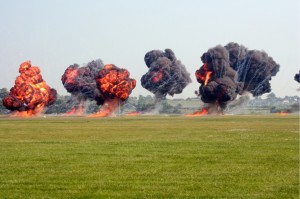
The image shows a powerful explosion occurring inside a room, with debris flying outwards from the center of the blast. The explosion has shattered the window and created a bright, fiery, chaotic scene.
Blow the Place Up!
 The ultimate goal of any Scrum implementation is to implement a profound and far-reaching transformation of a mediocre business into an industry leader for their market. If you merely want incremental improvements on the margins, then I suggest you try Kanban since it demands far less from seniors leaders, managers and the rest of the organization. In this last article in our series on Lean Concepts for Scrum (Part One and Part Two), I will explain the difference between incremental improvement (“kaizen”) and radical transformation (“kaikaku”) and offer my insights on why so many applications of Scrum flounder or just simply fade away.
The ultimate goal of any Scrum implementation is to implement a profound and far-reaching transformation of a mediocre business into an industry leader for their market. If you merely want incremental improvements on the margins, then I suggest you try Kanban since it demands far less from seniors leaders, managers and the rest of the organization. In this last article in our series on Lean Concepts for Scrum (Part One and Part Two), I will explain the difference between incremental improvement (“kaizen”) and radical transformation (“kaikaku”) and offer my insights on why so many applications of Scrum flounder or just simply fade away.
KAIZEN – “improvement”
Kaizen is a daily process for improvement, the purpose of which goes beyond simple increases in productivity. To be successful with kaizen, workers in a Lean organization are taught how to identify and eliminate waste in their business using the scientific method. The goal of kaizen is to humanize the workplace by eliminating unreasonable work, reduce inconsistencies between policies and foster the workers’s creativity through experimentation. This dual approach of leveraging the workers ideas and making incremental improvements each day is considered the key to increasing productivity.
In Scrum, the Retrospective is equivalent to kaizen. At the end of each Sprint, the Team members, Product Owner and ScrumMaster come together for a short, timeboxed conversation (somewhere between fourth-five and seventy-five minutes) to look for improvements and commitment to incremental change. The Retrospective agenda is set by the ScrumMaster and is facilitated by the ScrumMaster, using techniques identified in Agile Retrospectives and Gamestorming. However, the Team has the authority to override the agenda to discuss whatever they feel is important since the Retrospective is designed to serve the Team.
Every Retrospective must have at least one action item that humanizes the workplace in some way, eliminates some unnecessary policy, makes the Team stronger and\or improves the quality of the product. Otherwise, the Retrospective is simply an opportunity to bitch-and-moan about the workplace and people can do that in their own time at lunch or over coffee. IME, the Retrospective is how the members of the Team make the process of Scrum their own and serve their needs. In addition, I also recommend that the ScrumMaster use an early Retrospective to teach the participants how to identify the seven wastes of software development.
KAIKAKU – “radical change”
Kaikaku means that an entire business is changed radically. Kaikaku is about introducing new knowledge, strategies, approaches, production techniques and\or equipment. Since kaikaku is disruptive, it is initiated by senior management, executives and other senior leaders when they recognize that ongoing kaizen work is beginning to stagnate and no longer provides adequate results in relation to the effort. Often external factors, i.e. new technology, market conditions or competitive pressures, will drive this need for radical change. Kaikaku projects often result in improvements of 30% to 50% and form the new baseline for continued kaizen.
Scrum by its very nature is about transformative change. For most organizations, simply implementing all the Scrum meetings and roles is a profound change. The discipline required to execute Scrum, such as dedicated teams or prioritizing the business requests from 1 to n, can put significant demands on the business. The Spirit of Scrum, its values and principles of Scrum, at times can be in conflict with the unspoken norms of the organization or come into conflict with short term and long term business goals. Working in strict timeboxes that are neither expanded nor contracted requires more regular decision making from business leaders and greater discipline to not alter course in between the boundaries of the timebox.
By introducing the three Scrum roles to the organization, each with specific rights and responsibilities, interactions between business, technology and management are profoundly altered. The Team is offered the opportunity to become self-organizing and is allowed to succeed or fail on their own. The Product Owner has complete authority over the business goals and objectives and has the authority to apply their personal and professional best judgement to balance the conflicting needs and desires of the Stakeholders. Scrum adds the role of a full-time ScrumMaster, not as an extra set of hands to do the work of the Team or support the Product Owner in achieving business objectives, but as leader, guide and a facilitator of the process (LINK). The ScrumMaster is present in the framework to support the continued growth and development of the Team, the Product Owner and the business to support deeper and deeper levels of organizational change, yet the ScrumMaster is without the authority to compel people to follow his or her suggestions.
So why do we see so many applications of Scrum flounder? IMO, there are two main reasons why we see Scrum fade away from many organizations.
- Lack of executive understanding about the nature of the change they are introducing – Most business leaders and executives who decide to use Scrum do not understand that at the heart of Scrum is a radical reimagining of their business. They think Scrum is something other people do and neatly fits into an IT (or development) box. Many do not understand that the introduction of Scrum is like dropping a stone into a still lake and the ripples of change eventually fan out across the organization. The longer Scrum lasts in the organization, the more it will disrupt in the business.
- Lack of regular & consistent executive participation to remove organizational impediments – As Scrum Teams encounter organizational impediments, in the form of inflexible policies, meaningless procedures and excessive bureaucracy, many senior leaders and executives fail to grasp that all the impediments Scrum Team complain about are precisely the anchors that are preventing the business from being an industry leader. What makes Scrum successful is the recognition by senior leaders and executives that executive leadership and attention is needed to eliminate these organizational impediments. Without their active participation, the organization will simply not change due to the organizational inertia and its natural tendencies to protect the status quo.





